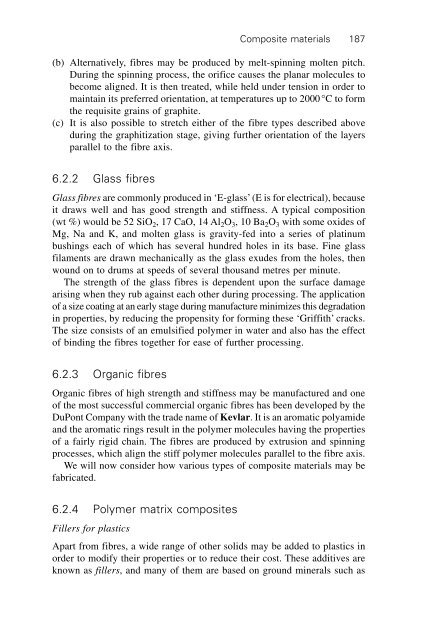Materials for engineering, 3rd Edition - (Malestrom)
Create successful ePaper yourself
Turn your PDF publications into a flip-book with our unique Google optimized e-Paper software.
Composite materials 187<br />
(b) Alternatively, fibres may be produced by melt-spinning molten pitch.<br />
During the spinning process, the orifice causes the planar molecules to<br />
become aligned. It is then treated, while held under tension in order to<br />
maintain its preferred orientation, at temperatures up to 2000°C to <strong>for</strong>m<br />
the requisite grains of graphite.<br />
(c) It is also possible to stretch either of the fibre types described above<br />
during the graphitization stage, giving further orientation of the layers<br />
parallel to the fibre axis.<br />
6.2.2 Glass fibres<br />
Glass fibres are commonly produced in ‘E-glass’ (E is <strong>for</strong> electrical), because<br />
it draws well and has good strength and stiffness. A typical composition<br />
(wt %) would be 52 SiO 2 , 17 CaO, 14 Al 2 O 3 , 10 Ba 2 O 3 with some oxides of<br />
Mg, Na and K, and molten glass is gravity-fed into a series of platinum<br />
bushings each of which has several hundred holes in its base. Fine glass<br />
filaments are drawn mechanically as the glass exudes from the holes, then<br />
wound on to drums at speeds of several thousand metres per minute.<br />
The strength of the glass fibres is dependent upon the surface damage<br />
arising when they rub against each other during processing. The application<br />
of a size coating at an early stage during manufacture minimizes this degradation<br />
in properties, by reducing the propensity <strong>for</strong> <strong>for</strong>ming these ‘Griffith’ cracks.<br />
The size consists of an emulsified polymer in water and also has the effect<br />
of binding the fibres together <strong>for</strong> ease of further processing.<br />
6.2.3 Organic fibres<br />
Organic fibres of high strength and stiffness may be manufactured and one<br />
of the most successful commercial organic fibres has been developed by the<br />
DuPont Company with the trade name of Kevlar. It is an aromatic polyamide<br />
and the aromatic rings result in the polymer molecules having the properties<br />
of a fairly rigid chain. The fibres are produced by extrusion and spinning<br />
processes, which align the stiff polymer molecules parallel to the fibre axis.<br />
We will now consider how various types of composite materials may be<br />
fabricated.<br />
6.2.4 Polymer matrix composites<br />
Fillers <strong>for</strong> plastics<br />
Apart from fibres, a wide range of other solids may be added to plastics in<br />
order to modify their properties or to reduce their cost. These additives are<br />
known as fillers, and many of them are based on ground minerals such as



